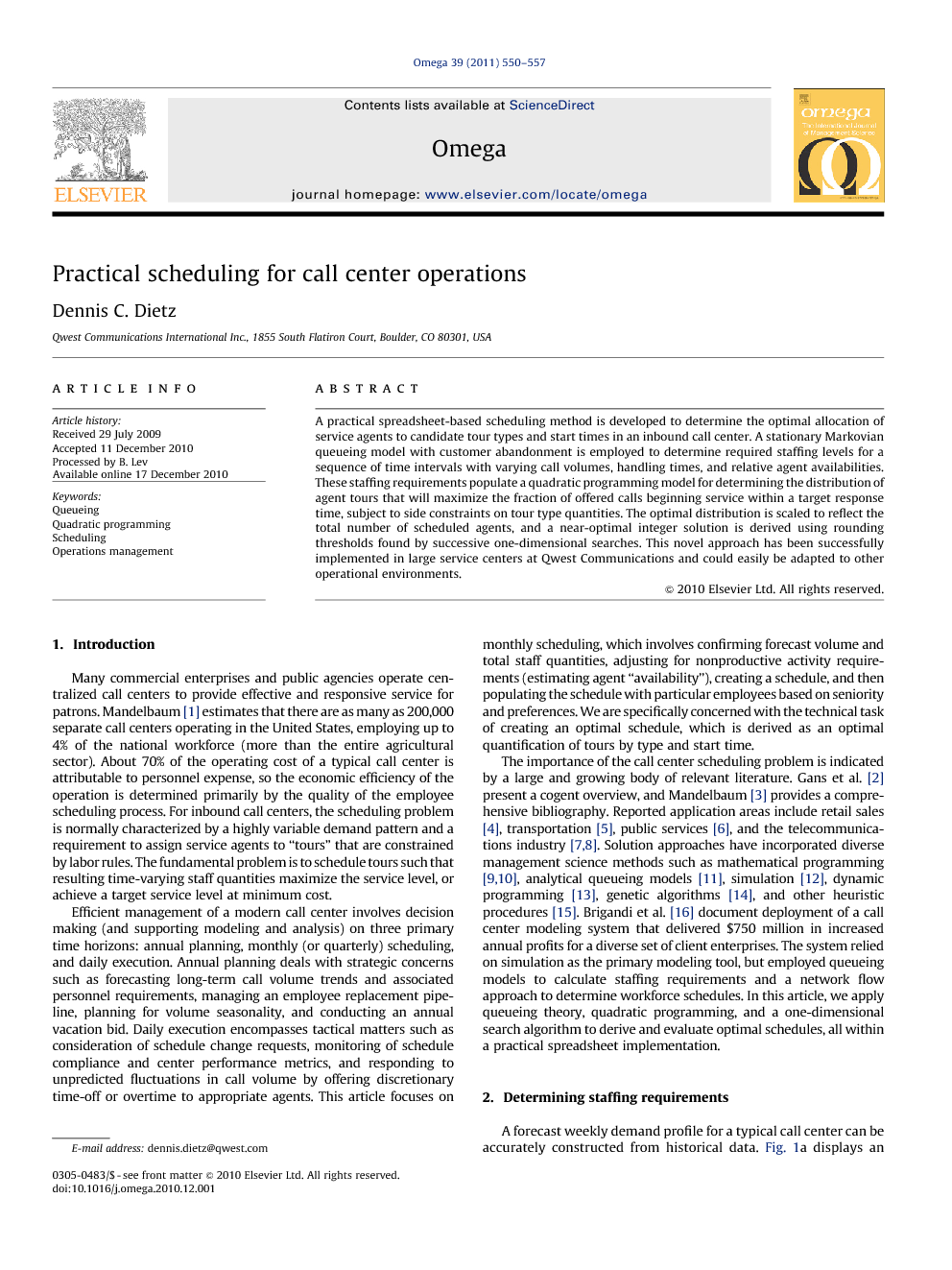ترجمه فارسی عنوان مقاله
برنامه ریزی عملی برای عملیات های مرکز تماس
عنوان انگلیسی
Practical scheduling for call center operations
| کد مقاله | سال انتشار | تعداد صفحات مقاله انگلیسی |
|---|---|---|
| 11820 | 2011 | 8 صفحه PDF |
منبع

Publisher : Elsevier - Science Direct (الزویر - ساینس دایرکت)
Journal : Omega, Volume 39, Issue 5, October 2011, Pages 550–557
فهرست مطالب ترجمه فارسی
چکیده
کلمات کلیدی
1.مقدمه
2. تعیین الزامات به کارگیری
3. بهینه سازی برنامه
4. اجرا و نتایج
5. نتیجه گیری
کلمات کلیدی
1.مقدمه
2. تعیین الزامات به کارگیری
3. بهینه سازی برنامه
4. اجرا و نتایج
5. نتیجه گیری
ترجمه کلمات کلیدی
صف - برنامه نویسی درجه دوم - برنامه ریزی - مدیریت عملیات -
کلمات کلیدی انگلیسی
Queueing, Quadratic programming, Scheduling, Operations management,
ترجمه چکیده
یک روش برنامه ریزی عملی مبتنی بر صفحه گسترده توسعه یافت تا تخصیص بهینه ی ماموران خدماتی جهت کاندید کردن انواع تور و زمان های آغاز در یک مرکز تماس داخلی تعیین گردد. یک مدل صف بندی مارکوفی ایستا با واگذاری مشتری به کار گرفته شد تا سطوح به کارگیری مورد نیاز برای یک توالی از فواصل زمانی با حجم تماس ها، زمان های رسیدگی، و قابلیت متغیر نسبی ماموران تعیین گردد. این الزامات به کارگیری یک مدل برنامه نویسی درجه دوم برای تعیین توزیع تور های ماموران ایجاد می کند که شکاف خدمت آغاز تماس های پیشنهاد شده در یک زمان واکنش مقصود را در کنار محدودیت های مربوط به کمیت های انواع تور بیشینه خواهد کرد. توزیع بهینه مقیاس بندی شد تا تعداد کلی ماموران برنامه ریزی شده را منعکس کند، و یک راهکار صحیح نزدیک به بهینه با استفاده از آستانه های گرد کردن یافته شده توسط جستجو های تک بعدی متوالی استنتاج شد. این رویکرد جدید به صورت موفقیت آمیز در مراکز خدماتی بزرگ در شرکت ارتباطات Qwest اجرایی شد و می توان آن را به آسانی برای دیگر محیط های عملیاتی اتخاذ کرد.
ترجمه مقدمه
بسیاری از شرکت های تجاری و ادارات عمومی از مراکز تماس متمرکز برای ارائه دادن خدمت مسئولیت پذیر و کارآمد برای مشتریان استفاده می کنند. ماندلبائوم [1] تخمین زد که حدود 200 هزار مرکز تماس مجزا در ایالات متحده فعالیت دارند، که حدود 4% نیروی کار ملی را استخدام کرده اند (چیزی بیش از کل بخش کشاورزی). حدود 70% از هزینه های عملیانی یک مرکز تماس معمولی مختص به هزینه های کارکنان است، در نتیجه بهره وری اقتصادی عملیات در درجه ی اول توسط کیفیت فرایند برنامه ریزی کارکنان تعیین می شود. برای مراکز تماس داخلی، مسئله ی برنامه ریزی به صورت عادی توسط یک الگوی تقاضای بشدت متغیر و الزام برای اختصاص ماموران خدماتی برای «تور هایی» که توسط قوانین کار محدود شده اند مشخص می گردد. مسئله ی اصلی عبارت است از برنامه ریزی تور ها به شکلی که تعداد کارکنان متغیر نسبت به زمان سطح خدمات را بیشینه کنند، یا با کمترین هزینه سطح خدمات هدف را بدست آورد.
مدیریت مناسب از یک مرکز تماس مدرن شامل تصمیم گیری (مدلسازی و تحلیل) در سه حوزه ی زمانی اصلی است: برنامه ریزی سالانه، زمان بندی ماهانه (یا فصلی)، و اجرای روزانه. برنامه ریزی سالانه با موضوعات استراتژیک مانند پیش بینی بلند مدت روند حجم تماس ها و الزامات مرتبط با کارکنان، مدیریت یک خط جانشینی کارکنان، برنامه ریزی برای حجم فصلی، و ایجاد یک پیشنهاد تعطیلات سر و کار دارد. اجرای روزانه شامل موضوعات تاکتیکی مانند در نظرگیری درخواست های تغییر برنامه، نظارت بر اجرای برنامه و سنجش عملکرد مرکز، و واکنش به نوسانات پیش بینی نشده در حجم تماس با ارائه ی زمان خاموشی اختیاری یا اضافه کاری برای ماموران مناسب است. این مقاله بر روی زمان بندی ماهانه تمرکز می کند، که شامل تایید حجم پیش بینی و تعداد کلی کارکنان، تنظیم الزامات فعالیت غیر تولیدی (تخمین «قابلیت» مامور)، ایجاد یک برنامه، و سپس ارائه ی آن برای کارکنان خاص مبتنی بر ارشدیت و اولویت ها می شود. ما به طور خاص در مورد وظیفه ی فنی ایجاد یک برنامه ی بهینه بحث می کنیم، که به عنوان یک تعیین کمیت بهینه ی تور ها از لحاظ نوع و زمان آغاز استنتاج می شود.
اهمیت مسئله ی برنامه ریزی مرکز تماس از رشد پژوهش های مرتبط با این موضوع مشخص است. گانز و همکارانش [2] یک بررسی دقیق انجام دادند، و ماندلبائوم [3] یک نظریه جامع را ارائه داد. گزارش ها شامل موضوعات مربوط به خرده فروشی ها [4]، انتقال [5]، خدمات عمومی [6]، و صنعت ارتباط از راه دور [7,8] می شود. رویکرد های راهکاری روش های علمی مدیریت تنوع مانند برنامه نویسی ریاضی [9,10]، مدل های صف بندی تحلیلی [11]، شبیه سازی [12]، برنامه نویسی پویا [13]، الگوریتم های ژنتیک [14]، و دیگر روند های اکتشافی [15] را ادغام کردند. بریگاندی و همکارانش [16] ایجاد یک سیستم مدلسازی مرکز تماس که سود سالانه ی آن برای مجموعه ی پراکنده ای از شرکت ها به 750 میلیون دلار می رسید را مستند سازی کردند. این سیستم بر شبیه سازی به عنوان ابزار مدلسازی اصلی تکیه داشت، اما مدل های صف بندی را برای محاسبه ی الزامات به کارگیری و یک رویکرد جریان شبکه را جهت تعیین برنامه های نیروی کار مورد استفاده قرار داد. در این مقاله، ما نظریه ی صف بندی، برنامه نویسی درجه دوم، و یک الگوریتم جستجوی تک بعدی را برای استنتاج و ارزیابی برنامه های بهینه اعمال می کنیم، که همگی این ها در یک اجرای عملی از صفحه ی گسترده نمایان است.

